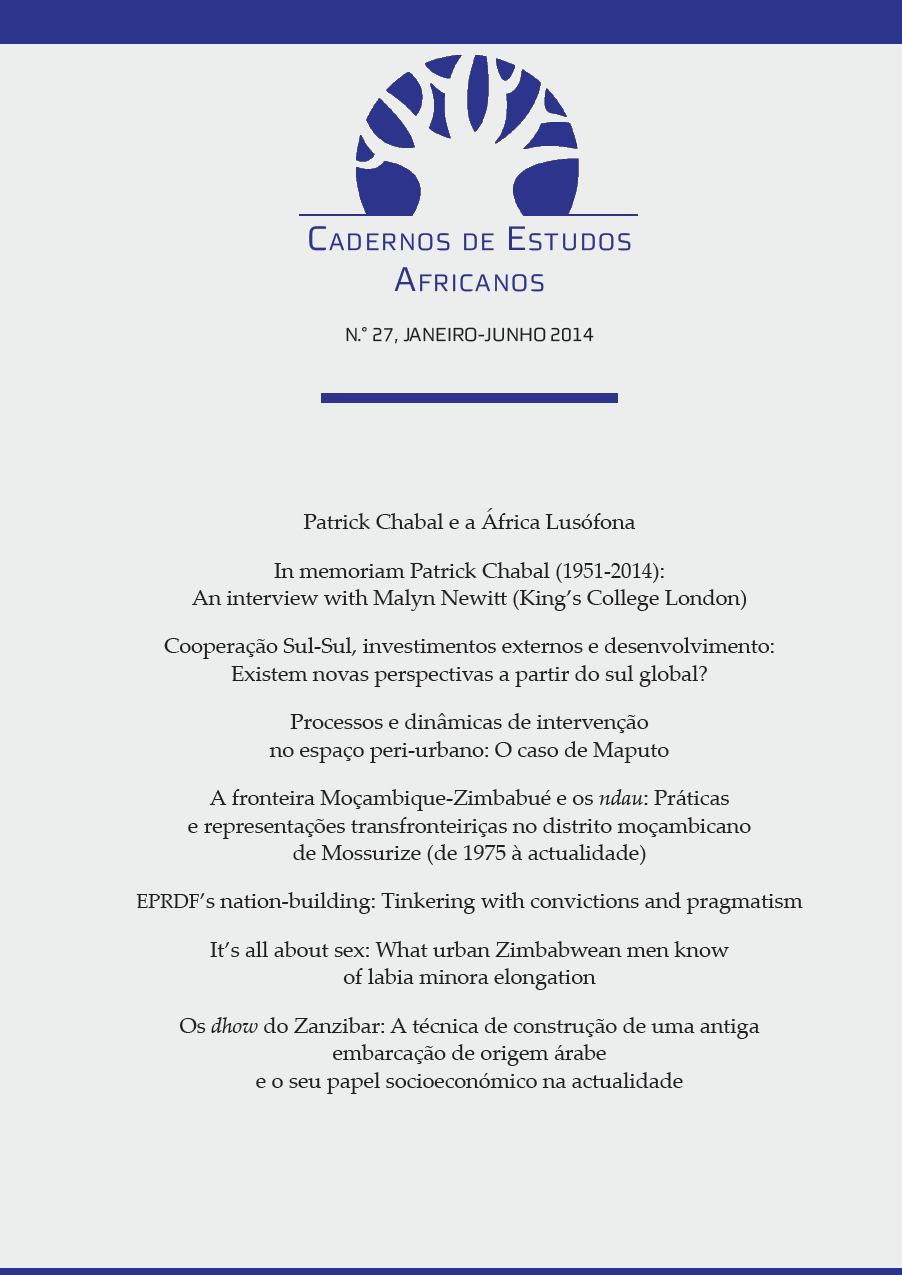Os Dhow do Zanzibar: A técnica de construção de uma antiga embarcação de origem árabe e o seu papel socioeconómico na actualidade
DOI:
https://doi.org/10.4000/cea.1535Palavras-chave:
Zanzibar, dhow, técnica de construção, barco, pesca artesanal, comércio insularResumo
Observámos em Zanzibar esta embarcação milenar, o dhow, ainda em uso. Nas localidades de Nungwi e Stone Town funcionam os estaleiros de construção destas embarcações nos quais se usam exclusivamente ferramentas manuais antigas. Grande parte da actividade piscatória do arquipélago é feita com os dhow, que efectuam também navegação de cabotagem para transporte de mercadorias e passageiros. Nas comunidades litorais ligadas à pesca, a organização social e as actividades económicas assentam em boa parte na construção e utilização destas embarcações. Em virtude da escassez das madeiras exóticas (mogno, teca e mangueira) usadas na sua construção, os dhow tradicionais parecem condenados a desaparecer.Referências
Bakari, M. A. (2001). The democratization process in Zanzibar. Hamburgo: German Institute of Global and Area Studies.
Brownell, W. N. (1982). Regional project for the development and management of fisheries in the Southwest Indian Ocean, SWIOP/WP/3-Tanzania baseline study. Document RAF/79/065/WP/03/82. Roma: Food and Agriculture Organization.
Campbell, I. C. (1995). The lateen sail in world history. Journal of World History, 6 (1), 1-23.
Gilbert, E. (2004). Dhows and the colonial economy of Zanzibar, 1860-1970. Athens: Ohio University Press.
Hattendorf, J. B. (Ed.) (2007). Introduction. Oxford encyclopedia of maritime history (Vol. 1). Oxford UniversityPress.
Ikor, O. (2011). Caravelas. O século de ouro dos navegadores portugueses. Lisboa: Casa das Letras.
Lloyd, C. (1949). The Navy and the slave trade: The suppression of the African slave trade in the nineteenth century. Londres: Frank Cass and Co Ltd.
Mattoso, J. (Dir.) (2010). Património de origem portuguesa no mundo II: Arquitectura e urbanismo: África, Mar Vermelho, Golfo Pérsico. Lisboa: Fundação Calouste Gulbenkian.
Ministry of Information, Sultanate of Oman. (2012). The traditional dhow. In http://www.omanet.om/english/culture/boats.asp?cat=cult (acedido a 12 Novembro de 2012).
Nabataea.net. (2002). The history and construction of the dhow. In http://nabataea.net/ships.html (acedido a 15 de Novembro de 2012).
National Bureau of Statistics. (2011a). Tanzania in figures 2010. Dar es Salaam: National Bureau of Statistics, Ministry of Finance, Republic of Tanzania.
National Bureau of Statistics (2011b). Statistics for development. In http://www.nbs.go.tz (acedido a 15 Novembro de 2012).
Richmond, M. D., Villiers, A., & Mkenda, A. F. (2003). Livelihood assets required for an East Africa FADs programme. Final technical report, Project FMSP R8249. Dar es Salaam, Tanzania: Samaki Consultants.
Roger, T. (2005). Zanzibar ships. In http://www.zanzibarhistory.org/zanzibar_ships.htm (acedido a 12 de Novembro de 2012).
Sheriff, A., & Ferguson, E. (Eds.) (1991). Zanzibar under colonial rule. Londres: James Currey.
Tripati, S., & Raut, L. N. (2006). Monsoon wind and maritime trade: A case study of historical evidence from Orissa, India. Current Science, 90 (6), 864-869.
Triplett, G. W. (1971). Zanzibar: The politics of revolutionary inequality. The Journal of Modern African Studies, 9 (4), 612-617.
DOI : 10.1017/S0022278X0005285X
Velho, A., Köpke, D., & Paiva, A. da Costa Castello de (1838). Roteiro da viagem que em descobrimento da India pelo Cabo da Boa Esperança fez dom Vasco da Gama em 1447: Segundo um manuscripto coetaneo existente na Bibliotheca publica portuense. Porto: Typographia Commercial Portuense.
Villiers, A. (2006). Sons of Sinbad: An account of sailing with the Arabs in their dhows, in the Red Sea, around the coasts of Arabia, and to Zanzibar and Tanganyika; pearling in the Persian Gulf; and the life of the shipmasters, the mariners, and merchants of Kuwait. Londres: Arabian Publishing (Obra original publicada em 1940).
Vosmer, T. (1997a). The durable dhow. Archeology, 50 (3). In http://www.archaeology.org/9705/abstracts/dhow.html (acedido a 12 de Novembro de 2012).
Vosmer, T. (1997b). Indigenous fishing craft of Oman. The International Journal of Nautical Archeology, 26 (3), 217-235.
DOI : 10.1006/ijna.1997.0088
Yajima, H. (1977). Maritime activities of the Arab Gulf people and the Indian Ocean world in the eleventh and twelfth centuries. Journal of the Asian and African Studies, 14, 195-208.
Downloads
Publicado
Edição
Secção
Licença
Direitos de Autor (c) 2016 Cadernos de Estudos Africanos

Este trabalho encontra-se publicado com a Licença Internacional Creative Commons Atribuição-NãoComercial-CompartilhaIgual 4.0.
Autorizo a publicação do artigo/recensão submetido do qual sou autor.
Declaro ainda que o presente artigo é original, que não foi objecto de qualquer tipo de publicação, e cedo em exclusivo os direitos de publicação à revista Cadernos de Estudos Africanos. A reprodução do artigo, no todo ou em parte, noutras publicações ou noutros suportes depende de autorização prévia da editora Centro de Estudos Internacionais do Iscte - Instituto Universitário de Lisboa.

